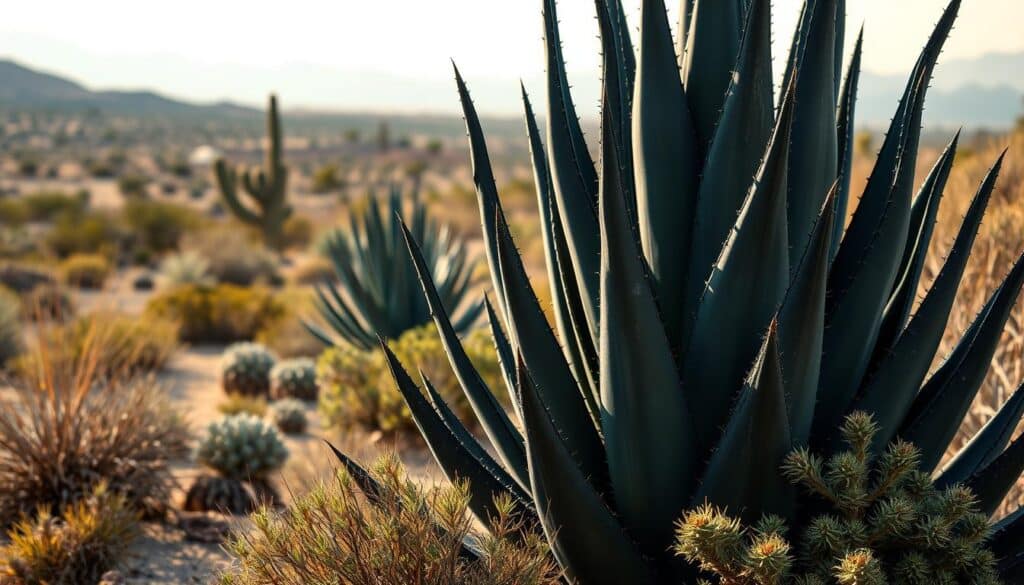As someone passionate about desert gardening, I’ve always been captivated by plants that thrive in arid conditions. Among these, the Black Spine Agave (Agave macroacantha) stands out as a true gem. Native to the sun-kissed regions of Oaxaca and Puebla in Mexico, this striking succulent has become a centerpiece in my garden, and for good reason.
Its narrow, powder-blue leaves are adorned with a striking black-brown spine, creating a rosette that’s as decorative as it is resilient. I’ve found that this plant flourishes under full sun, though it appreciates some afternoon shade in the low desert climate. Whether planted in the ground or a container, the Black Spine Agave offers a perfect blend of beauty and low-maintenance care.
What draws me to this succulent is its ability to add both drama and elegance to any garden. It’s not just about aesthetics; the Black Spine Agave also offers practical benefits for gardeners looking for a hardy, drought-tolerant option. In the following sections, I’ll share practical tips on how to care for and propagate this desert treasure, drawing from both personal experience and expert insights. Let’s dive into the world of the Black Spine Agave and uncover its secrets together!
Getting to Know the Black Spine Agave
For desert garden enthusiasts like myself, understanding the origins and characteristics of plants is key to appreciation. The Black Spine Agave, scientifically known as Agave macroacantha, offers fascinating insights into its nature and growth habits.
Scientific Background and Origins
Native to the semi-tropical climates of central Mexico, specifically Oaxaca and Puebla, this plant belongs to the Asparagaceae family. Its scientific name, Agave macroacantha, reflects its large, thorny flowers. This succulent has adapted to regions with limited rainfall, making it ideal for arid environments.
Distinctive Physical Characteristics
The Black Spine Agave features rigid, powder-blue leaves forming a dense rosette. The sharp, dark-tipped spines add a striking element to its appearance. Over time, it develops a tall flower stalk, reaching up to 15 feet, adorned with green flowers and bulbils for propagation.
This succulent’s slow growth and hardiness make it perfect for small desert gardens or containers. It thrives in full sun with partial afternoon shade, a common need in low-desert climates. Whether in a rock garden or a container, the Black Spine Agave adds unique texture and beauty, enhancing any landscape with its resilient charm.
Essential Tips to Care for black spine agave
Caring for the Black-Spined Agave is straightforward once you understand its needs. This succulent thrives in conditions that mimic its natural desert habitat. By focusing on sunlight, water, and soil, you can create an ideal environment for your plant to flourish.
Optimal Sunlight, Water, and Soil Requirements
Lighting plays a crucial role in the health of your Black-Spined Agave. In milder climates, full sun is ideal, but in hotter areas, providing some afternoon shade can prevent stress. When it comes to watering, remember: less is more. During summer, minimal watering is sufficient, as overwatering can lead to root rot.
The soil type is another critical factor. Use well-drained, sandy or rocky soil to ensure water doesn’t linger around the roots. This mimics the plant’s natural habitat and promotes healthy growth.
Choosing the Right Container and Garden Environment
Selecting the right container is essential for your Black-Spined Agave. Opt for one that offers good drainage and mirrors its natural rocky surroundings. If planting in a garden bed, ensure the area has excellent drainage and air circulation to prevent fungal issues.
Consider placing your agave in a rock garden or border for a visually appealing setup. Proper spacing allows for air circulation, which is vital for the plant’s health. By following these guidelines, you’ll create a thriving environment for your Black-Spined Agave.

Advanced Propagation and Maintenance Techniques
Sharing the joy of growing the Black-Spined Agave, I’m excited to dive into advanced techniques for propagating and maintaining this stunning succulent. Whether you’re a seasoned gardener or just starting out, these tips will help you expand your desert garden with ease.
Propagation Methods: Division, Bulbils, and Rhizomes
Propagating your Black-Spined Agave can be done through basal offshoots, bulbils, or seeds. Division is the most effective method, involving the separation of basal offshoots (or ramets) from the mother plant using sturdy gloves and tools. While bulbils and seeds are viable alternatives, they are less commonly used due to longer maturation periods.
| Method | Effectiveness | Time to Maturity | Difficulty |
|---|---|---|---|
| Division | High | Short | Easy |
| Bulbils | Medium | Medium | Easy |
| Seeds | Low | Long | Challenging |
Managing Growth and Long-Term Care
Maintenance is relatively low for the Black-Spined Agave. Pruning is minimal, focusing on removing dead leaves to maintain a tidy appearance. Monitoring the plant’s height and spread is essential as it forms tight rosettes over time. Proper care ensures the plant’s hardiness, whether in summer or winter climates.
Final Reflections on Enhancing My Desert Garden
Reflecting on my journey with the Black-Spined Agave, I am captivated by its striking appearance and resilience. This plant has brought a unique charm to my desert garden, blending drama with low-maintenance care. Its ability to thrive in harsh conditions makes it perfect for small spaces or containers.
Understanding its scientific background and care needs has deepened my appreciation. The right soil type and drainage are crucial, ensuring it flourishes in our arid climate. Whether in a rock garden or a planter, it transforms any area with its elegant rosettes.
I encourage fellow gardeners to consider the Black-Spined Agave for its visual impact and ease of care. Propagation and maintenance are straightforward, allowing me to expand my garden effortlessly. I invite you to share your experiences or contact me for tips on nurturing this desert treasure.
